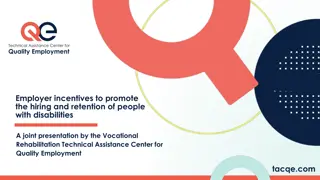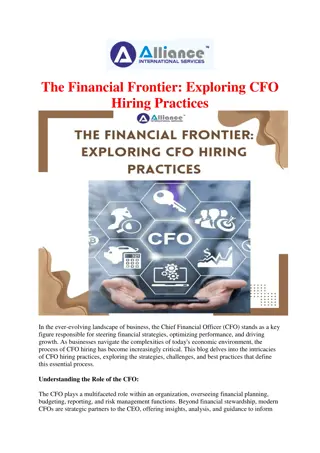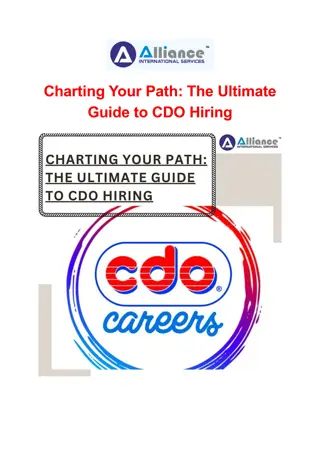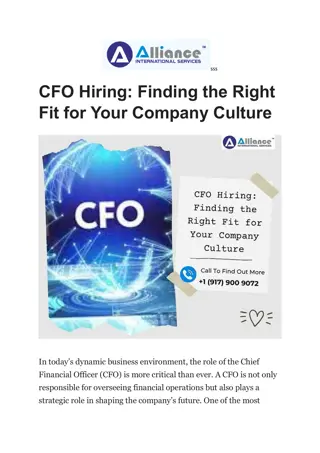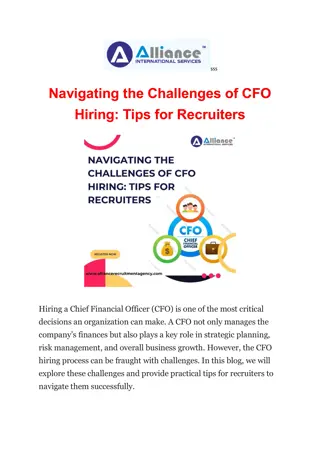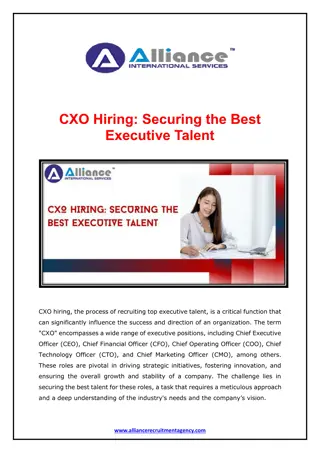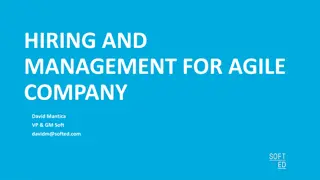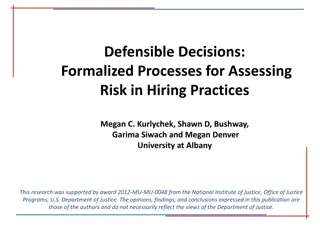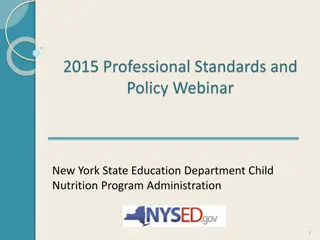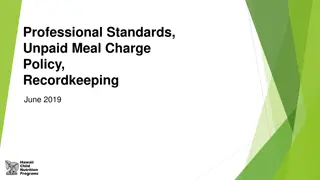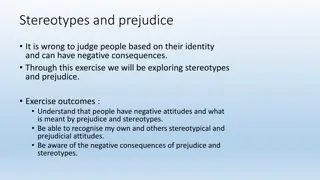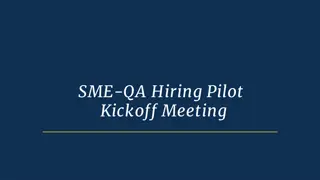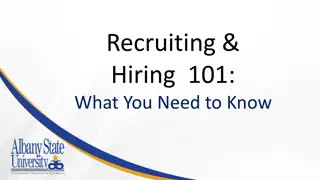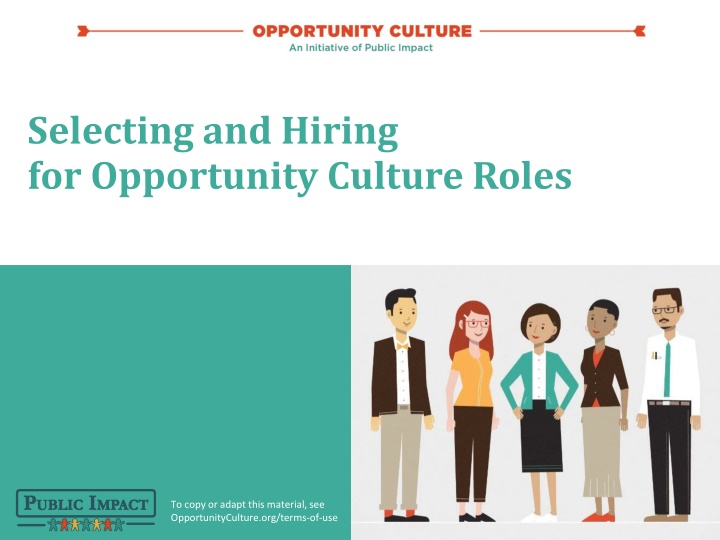
Effective Selection and Hiring Strategies for Opportunity Culture Roles
Discover key strategies for selecting and hiring employees in an Opportunity Culture setting, explore district and school-level processes, and learn about best practices for attracting top talent in educational environments.
Download Presentation

Please find below an Image/Link to download the presentation.
The content on the website is provided AS IS for your information and personal use only. It may not be sold, licensed, or shared on other websites without obtaining consent from the author. If you encounter any issues during the download, it is possible that the publisher has removed the file from their server.
You are allowed to download the files provided on this website for personal or commercial use, subject to the condition that they are used lawfully. All files are the property of their respective owners.
The content on the website is provided AS IS for your information and personal use only. It may not be sold, licensed, or shared on other websites without obtaining consent from the author.
E N D
Presentation Transcript
Selecting and Hiring for Opportunity Culture Roles To copy or adapt this material, see OpportunityCulture.org/terms-of-use 2019 |1
School Excellence Portal Log on to the OC School Excellence Portal: opportunityculture.org/portal Having Problems? Let us know here! 2019 |2
Snap Chat Find a partner, reintroduce yourself, and share one picture you took over winter break. 2019 |3
Session Objectives Learn about this year s district selection process for Opportunity Culture teachers. Reflect on last year s school selection process and begin planning for the upcoming hiring season. 2019 |4
District-Level OC Selection Process District Level Screen 1: Checklist District Level Screen 2: Rubric District BEI Interviews District Talent Pool Open Open Pool to Principals January 9 February 20 January 9 February 23 February 26 March 2 January 8 March 3 Applicants submit: Resume Essay responses Data submission Evaluation data HR screens for basic job requirements: Certification Years experience Application components complete Data meets requirement Evaluation scores meet requirement Hiring Team: Evaluate essay responses on rubric Rank candidates Invite top candidates to in- person interview Hiring Team: Conduct Behavioral Event Interview on the following competencies: Belief in Students Achievement Impact and Influence Hiring Team provides final candidate ranking & allow principals access to the pool 2019 |5
School-Level Selection and Hiring Concept Map On chart paper, map out each step of your school s selection and hiring process for Opportunity Culture candidates last year, beginning when you get the candidates from central office and ending with the offer letter. Image source: http://www.3mdirect.co.uk/home-and-office/post-it-notes-products.html Time for this activity: 5 minutes 2019 |6
Partner Discussion 1. Share an overview of your selection concept map. 2. What is going well with your selection process? 3. What would you like to improve? Time for discussion: 10 minutes 2019 |7
The Why An average school district has 1.8 people working on recruitment. Capacity Job Only 30% of school districts post jobs on social media. Postings Only 13% of districts require a demonstration or a sample performance lesson with students. Selection Statistics source: Center for American Progress 2019 |8
Strong Selection Process Determine Selection Criteria Conduct Initial Screening Conduct Advanced Screening Perform Reference Check 2019 |9
Overview of Selection Resources See Handout 2019 |10
Selection Process Determine Selection Criteria Conduct Initial Screening Conduct Advanced Screening Perform Reference Check 2019 |12
Step 1: Determine Selection Criteria Confirm OC roles needed for next school year. Identify non-negotiables, such as certifications, experience, or resume requirements. Determine skills, such as differentiating instruction based on student data, that will be prioritized for your school. Determine competencies, such as achievement or impact & influence, that will be prioritized for your school. All subsequent activities in the selection process should connect back to and evaluate each candidate on these chosen competencies. 2019 |13
Competencies by OC Role See Handout Principal MCL TRT RA Achievement Achievement Achievement Achievement Impact & Influence Impact & Influence Impact & Influence Impact & Influence Cultural Engagement Cultural Engagement Cultural Engagement Cultural Engagement Planning Ahead Planning Ahead Planning Ahead Concern for Order Developing Others Developing Others Developing Others Serving Others Team Leadership Team Leadership Teamwork Initiative & Persistence Initiative & Persistence Monitoring & Directiveness Monitoring & Directiveness Belief in Learning Potential Analytical Thinking Conceptual Thinking Flexibility Self-Confidence 2019 |14
Work Time See Handout Determine one or two competencies your school will prioritize for each Opportunity Culture role. Choose from the district s preferred competencies, or you could add a new one if it aligns better with your school s mission. Turn to p.7 of the Behavioral Event Interview Packet for a list of all competencies, and visit http://opportunityculture.org/selection- toolkit/step-1/ to find all competency definitions. 2019 |15
Selection Process Determine Selection Criteria Conduct Initial Screening Conduct Advanced Screening Perform Reference Check 2019 |16
Step 2: Conduct Initial Screening 1. Review candidates in the district pool and determine whom to invite to an in-person interview day. Suggestion: Screen candidates for your selection criteria. Then sort remaining applicants into categories: high- potential, moderate-potential, and not a school fit. Suggestion: Choose candidates who warrant short outreach phone calls. 2. Conduct phone or video pre-screen interviews, as needed. 2019 |17
Phone Screen Resource 2019 |18
Selection Process Determine Selection Criteria Conduct Initial Screening Conduct Advanced Screening Perform Reference Check 2019 |19
Step 3: Conduct Advanced Screening 1. In-person interview with questions aligned to the prioritized competencies. 2. Skills demonstration. For example, Sample teaching lesson; different approaches to this: Sample lesson at your school with actual students. Sample mini lesson at your school with adults. Observe teaching at the candidate s current school. Perform a data analysis task. Observe a teaching video and lead a mock coaching conversation. 2019 |20
Types of Interviews Research indicates that structured interviews are vastly better at predicting job performance than unstructured interviews, and they generate fewer racial differences in ratings. Past Behavior Past Behavior Structured Structured In In- -person person Interview Interview Situational Situational Unstructured Unstructured Research indicates that past behavior interviews are more effective at predicting future job performance than situational interviews. 2019 |21
Behavioral Event Interviews Are research-based methods for assessing underlying competencies. Require candidate to describe past events in rich detail. Score responses that relate to each of the pre- determined competencies. 2019 |22
Impact and Influence 2019 |23
BEI Process Explain BEI Ask Question The interviewer shares what the candidate can expect in the interview. Probe A trained interviewer asks the applicant a question and provides a framework to recount a situation from a past job. Take Notes The interviewer asks clarifying and probing questions to pull more details about the situation. Evaluate Very detailed notes are taken by another member of the interview team. Responses are evaluated on pre-etermined rubrics for each predetermined competency. 2019 |25
Step 3: Conduct Advanced Screening 1. In-person interview with questions aligned to the prioritized competencies and skills. 2. Skills demonstration. For example, Sample teaching lesson. Different approaches to this: Sample lesson at your school with actual students. Sample mini lesson at your school with adults. Observe teaching at the candidate s current school. Perform a data analysis task. Observe a teaching video and lead a mock coaching conversation. 2019 |26
Small-Group Discussion 1. Look through resources together. 2. Which advanced screening activities interest you? How might you adapt them to fit your school s context? Behavioral Event Interview Sample Lesson Data Analysis Activity Mock Coaching Conversation 3. Who should serve on your interview team? Time for work time: 15 minutes 2019 |27
Selection Process Determine Selection Criteria Conduct Initial Screening Conduct Advanced Screening Perform Reference Check 2019 |28
Step 4: Reference Checks Reference checks are often a skipped or underused step in the selection process. Conduct informally through your existing networks, and/or more formally with forms for recommenders to fill out and standardized follow- up questions. Don t hesitate to seek feedback from trusted colleagues who have worked with the candidate (even if they are not identified as a reference). 2019 |29
Reference Check Resources See Handout 2019 |30
Selection Toolkit Selection Action Checklist Day-of Interview Tools Candidate Rating Tools Candidate Decision Tools Competency Rating Levels Check out http://opportunityculture.org/selection-toolkit/ 31 2019 |31
Revisit Concept Map Return to your chart paper to update your selection process based on your takeaways from today. 2019 |32
Action Items Write down 2-3 action items you commit to incorporating into your work based on your takeaways from this session. For example: Action Item People Timeline Status Notes Meet with leadership team to map out selection process and all tasks to complete before selection season begins. Me and ILT 1/15 Not complete 2019 |33
Exit Slip Thank you for your engagement and participation. Please complete the exit slip to provide feedback on this session prior to leaving. 2019 |34
Follow Us! Keep up to date on Opportunity Culture with resources and research from Public Impact by following: @OppCulture @PublicImpact Facebook.com/OpportunityCulture Facebook.com/PublicImpact LinkedIn.com/company/public-impact---chapel-hill-nc Subscribe to the quarterly Opportunity Culture newsletters, with content by and for Opportunity Culture educators, and sign up to get Remind messages for them: Remind.com/join/ocnew OpportunityCulture.org/mailing-list/ 2018 |35

